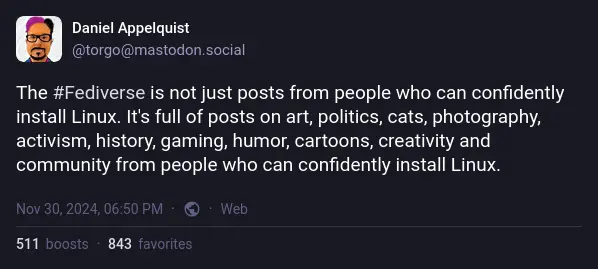this post was submitted on 01 Dec 2024
733 points (98.5% liked)
Fediverse memes
1611 readers
618 users here now
Memes about the Fediverse.
Rules
General
- Be respectful
- Post on topic
- No bigotry or hate speech
Specific
- We are not YPTB. If you have a problem with the way an instance or community is run, then take it up over at !yepowertrippinbastards@lemmy.dbzer0.com.
- Addendum: Yes we know that you think ml/hexbear/grad are tankies and or .world are a bunch of liberals but it gets old quickly. Try and come up with new material.
Elsewhere in the Fediverse
Other relevant communities:
- !fediverse@lemmy.world
- !yepowertrippinbastards@lemmy.dbzer0.com
- !lemmydrama@lemmy.world
- !fediverselore@lemmy.ca
- !bestofthefediverse@lemmy.ca
- !fedigrow@lemmy.zip
founded 9 months ago
MODERATORS
you are viewing a single comment's thread
view the rest of the comments
view the rest of the comments

There's a lot more to it than that. Which ISO do you download? How do you make the USB installable. What to do if the USB doesn't boot when you restart the computer. Do you want to manually partition things? What the hell's a partition?
There's installing Linux, then there's confidently installing Linux.
ISO? USB? What kind of amateur hour is this?
I just have a BOOTP server running on my LAN that allows me to netboot any x86 machine straight into the Debian installer.
Interesting. How do you host that?
I use dnsmasq on my router (I use a small server-grade PC as a router). It’s both a DHCP server as well as a caching DNS. Next to that it also runs a TFTP server. TFTP (Trivial File Transfer Protocol) is a standard for simple file transfers mainly used for network booting.
If you tell a machine to boot from the network, it will basically request an IP through DHCP and with that DHCP response comes a list of available network boot options. Each option is contains the name of a file it can load from the TFTP server. If you select one of the options, it will download that file and execute it. That file will usually be a bootloader (like Grub) which will then take over the boot process.
I have set up a bunch of different network boot options, including a Debian installer, a small Linux rescue system and Memtest86+ . That way I can always network-boot any machine on my LAN to either install an OS or diagnose problems.